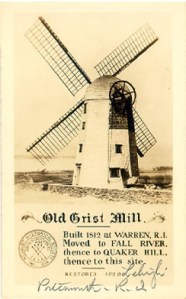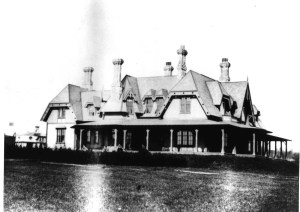
Sherman Mill at Lehigh Hill
The windmill at Prescott Farm has traveled far, but Portsmouth has been its home for most of its life. It was built in 1812 in Warren and served in connection to a distillery. It was moved to Fall River where John Sherman of Portsmouth bought the mill and ultimately dismantled it and rebuilt it on Quaker Hill. It was moved again to Lehigh Hill. It ceased being useful in the early 20th century. In 1969 the Newport Restoration Foundation acquired the mill, dismantled it, and carefully reconstructed at Prescott Farm.

1910 image of Sherman Mill
Sherman Mill Entries from David Durfee Sheaman Diaries
1858
5 May 1858
… Uncle John [Sherman] has bought a windmill in Fall River (RI) and Jonathan Sherman has contracted to take it down and move it here on his land west of the main road _ and put it up again. It was moved from Warren, to where it now stands.
15 May 1858
… Helped Jonathan Sherman unload the top of the Mill about 9 o’clock. He brought it in 6 parts, sawed through from top to plates at one load with 4 horses.
31 May 1858Built wall for Father (Benjamin C Sherman] he went to Fall River with Uncle John & Jonathan Sherman to help take down the Mill. They got three sides down & brought them home being after 10 o’clock when they got home. Weather fine & calm morning, light breeze from south afternoon.
1 June 1858
Built wall for Father. Uncle John’s hired man has been there two days helping us Uncle having Father’s Oxen to go after Mill. Warm part of day with little rain in the night. Jonathan did not get home untill 3 o’clock in the morning with the loads of Mill. 2 June 1858
8 June 1858
… Helped knock the shingles off the side of the Mill A.M. They re going to take them off and nail the boards on firm then lay the same shingles again. ..
11 June 1858
I done but little work today, feeling quite unwell; went up where the men was at work on the Mill. Helped them some about raising the poles to make a Derrick to put the Mill up with; they are near 50 feet long. The bottom of the Mill is laid and some of the sides ready to put up. Four men at work on her. Wind blowing from the southwest, thundered and rained at night just after six o’clock.
14 June 1858
… Jonathan raised two sides of the Mill today.
17 June 1858
I split some wood & George packed it up to dry. Went up to the Mill awhile and helped some. They got up all the sides but one.
25 June 1858
I worked for Jonathan on the Mill – shingling some and putting together the driving wheel on the main shaft. An exceedingly hot day …
26 June 1858
I worked for Jonathan today putting on the top of the Mill. Got it all on. Uncle is going to have it new shingled. Had a very favorable time being so still and very warm …
14 July 1858
… I went up to Uncle’s Mill afternoon – put up the arms- I helped some. They have got the machinery all put up and will finish it in a short time,
22 July 1858
… We went over then helped Uncle John get three loads of hay when it began to rain a little- then held up a while, then rained again a light shower. Jonathan Sherman finished Uncle’s Mill today. He had $500 for moving and putting it up in running order.
16 Aug. 1858
… Worked on Uncle Johns Mill-sails, patching and sowing up the rents, afternoon.
17 Aug 1858
More rain this morning and cloudy all day. Finished mending the sails. Jonathan Sherman came out from Newport and Mr. Borden came in the stage from Fall River to get the Mill in running order to grind corn. Mr.Borden was the owner of the Mill when Uncle John bought her. We went up and took up the Big stone (Runner) found that we should have to move the bed stone to make the wheels gear in to each other.
18 Aug 1858
Cut away the floor and moved the bedstone & leveled it & put on the Runner. Rigged the sails afternoon & started her up for the first time in 4 years. A damp, strong south-west wind- she went off smart with sails reefed; ground about 5 bushels of southern corn for feed – some was mixed with oats. Levi Cory bought two grists. The first one that was bought.
19 Aug 1858
We took up the Mill stone and packed it with the small picks (having 25 or 30 of them together) making the surface of the stone much finer than the old way of picking with a single pick and not taking a quarter of the time to do it. We started up and ground a little at night but the wind light from north west.
20 Aug 1858
Had to move the small bed-stone about an inch, wedging around it again; worked a good while to make the Break clear the driving wheel, and doing other small jobs. Started up the Mill and ground 6 bushels of flat corn, making fine meal for John Elared of Newport, get 6 cents a bush. For grinding; wind south west, whole sail breeze.
21 Aug 1858
Isaac Grinnell came out to set up the curb around the small stone (it is made of staves & hooped) and done one thing or another about the Mill. A fine clear day, wind west, light.
30 Sept 1858
Worked on the Mill- wedging the arms of the driving wheel to keep it firm and strong. Asa Tibbets was there & assisted us. Jonathan left many things undone which was needed to be done. Started up and ground 13 bushels of corn for feed, one bushel of round corn for Father, and one bushel of rye in less than two hours; wind blowing strong from west nor’west clear but cool and drying.















